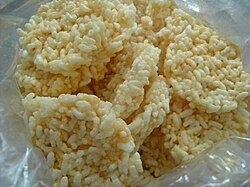 Rengginang | |
| Alternative names | Ranginang, intip (Javanese) |
|---|---|
| Type | Rice cracker |
| Course | Snack |
| Place of origin | Indonesia |
| Region or state | West Java, Banten |
| Created by | Sundanese cuisine |
| Serving temperature | Room temperature |
| Main ingredients | Rice |

Rengginang or ranginang is a variety of Indonesian thick rice crackers, made from cooked glutinous sticky rice and seasoned with spices, made into a flat and rounded shape, and then sun-dried. The sun-dried rengginang is deep-fried with ample cooking oil to produce a crispy rice cracker. [1]
Contents
This cracker is quite different from other types of traditional Asian crackers such as the Indonesian krupuk and the Japanese senbei or beika ; while most traditional crackers' ingredients are ground into a fine paste, rengginang retains the shapes of its rice grains. It is similar to the Japanese arare , and yet it differs because arare are individually separated larger rice pellets. In contrast, rengginang rice granules are stuck together in a flat-rounded shape. Rengginang is traditionally made from dried leftover rice. In Suriname, it is known as brong-brong.
Rengginang can be plain or flavoured sweet, salty or savoury. The most common rengginang are deep-fried with added pinches of salt for a traditional salty taste. Sweet rengginang uses thick liquified coconut sugar-coated or poured upon it. Other variants have other ingredients added to enrich the taste, such as dried prawn, terasi (shrimp paste), or lorjuk (razor clam).